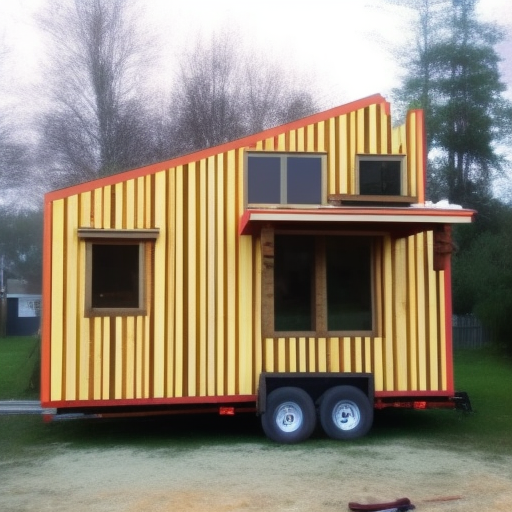So you’ve always wanted to build a tiny house…but what material should you use? It’s a tricky question as the answers can vary greatly depending on cost, availability, and the environment in which the home will be built. It’s important to learn more about the different materials available, in order to choose the one that is best for your own tiny house. In this article we’ll explore the pros and cons of several popular materials used to build tiny houses.
Benefits of Building with Tiny House Materials
One major benefit of building with tiny house materials is the cost savings. When you’re working with a limited amount of space, you can reduce the amount of materials needed, making it a more affordable option. For example, using smaller appliances can help you save money and reduce your overall energy consumption. Additionally, tiny house materials are often made from sustainable resources, which can be an eco-friendly choice.
Another benefit of using tiny house materials is the flexibility it provides. Since tiny homes are often portable, the materials used are designed to be lightweight and durable. This means that you can take your home with you wherever you go, without sacrificing comfort or style. Plus, the materials can withstand harsh weather conditions or extreme temperatures, making them ideal for those who prefer to live off the grid. Plus, with the trend of DIY tiny homes on the rise, building with tiny house materials makes it easy and convenient to create a stylish, functional home that meets your needs.
Types of Tiny House Materials
When it comes to choosing the material for your tiny house, there are a lot of options out there. Here are some of the most common materials you can use for your mini abode:
Wood
Using wood for your tiny house is a classic choice – it’s eco-friendly, sustainable, and has a warm, cozy feel. You can use traditional wood framing or opt for newer methods like “mass timber” (also known as cross-laminated timber or CLT), which involves stacking layers of wood panels. Not only is it strong enough to support a two-story house, but it also has excellent insulation properties. Plus, CLT is engineered to be perfectly straight and square, which means that your walls will be very precise. Some popular wood choices for tiny homes include cedar, pine, and redwood.
Metal
Metal is an affordable and durable option for tiny house construction. Steel is particularly popular because it’s strong and can withstand harsh weather conditions. Additionally, metal is lightweight and resists fire, rot, and pests. It’s also eco-friendly, as it’s fully recyclable – making it a great choice for those who are conscious of their environmental impact. Some examples of metal buildings used for tiny homes include shipping containers or repurposed metal buildings. These types of materials are not only cost-efficient, but they also provide a modern and sleek aesthetic.
Pros and Cons of Common Tiny House Materials
When it comes to building a tiny home, choosing the right material is crucial. The material you select will determine how comfortable and durable your tiny house will be for years to come. Here are some :
- Wood: Wood is a popular choice for tiny homes because of its natural aesthetic. It’s also easily customizable and energy-efficient. However, wood can be expensive and requires regular maintenance to protect against moisture and pests.
- Steel: Steel is sturdy, graffiti-resistant, and fireproof. It’s also lightweight, making it a great choice if you plan to move your tiny home frequently. However, steel can be noisy during rainstorms or hail and may require specialized equipment for construction.
- Concrete: Concrete is incredibly durable and can withstand extreme weather conditions. It’s also fireproof and relatively low-maintenance. But, concrete can be expensive, heavy, and may require specialized equipment and contractors for construction.
Each material has its own advantages and disadvantages, so it’s important to weigh your options carefully before deciding. Consider your budget, your needs, and your long-term goals for your tiny home. Whether you decide to use wood, steel, concrete, or another material, make sure to choose a high-quality product that will stand the test of time.
Tips for Choosing Tiny House Materials
When it comes to choosing materials for your tiny house, there are a few tips and tricks that can help you make the right decision. First and foremost, think about your lifestyle and the climate you’ll be living in. Are you someone who craves natural light and warmth? Or would you prefer a cozy, insulated space to hibernate in during the colder months? These factors will influence the materials you choose, from windows and doors to the insulation and roofing.
Another consideration is the cost of materials. While it may be tempting to choose the cheapest options available, keep in mind that your tiny house is an investment. Spending a little extra upfront can save you money in the long run, ensuring your home lasts for years to come. Plus, there are certain materials, like reclaimed wood or salvaged materials, that can actually add character and charm to your tiny house. Think outside the box and get creative when it comes to choosing your materials. That old fence post could become a feature piece in your kitchen or a unique wall panel in your bedroom. With some imagination and a little bit of elbow grease, you can create a space that’s truly one-of-a-kind. When it comes to building a tiny house, you have plenty of options to choose from. From wood and concrete to brick and stone, the possibilities are seemingly endless in creating your own unique living space. No matter the material you choose, remember that the best tiny homes come from choosing the one which best suits your needs and budget. So make a sound decision, be creative, and let your tiny house building dreams come to life!
Happy building!